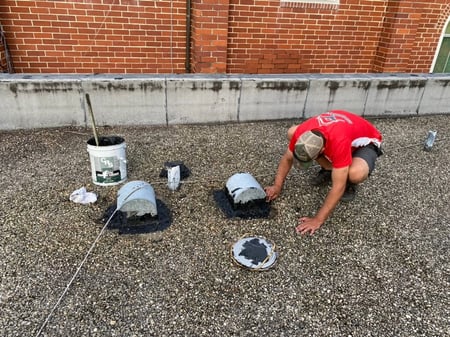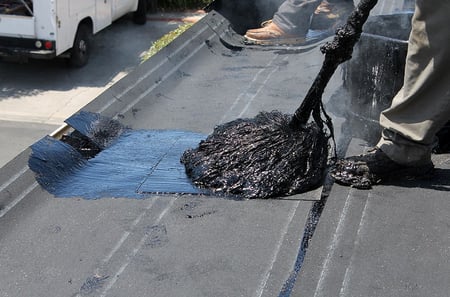
Tar and gravel roofs have been around for decades. They’re often found on commercial buildings or even homes with low-slope or flat roofs. Many contractors and building owners opted for this type of roof for its durability and cost-effectiveness, but the times are changing, people!
At RoofCrafters, we know that in 2024, tar and gravel roofs (like all things in life) are starting to show their age. Today’s construction landscape offers various advanced roofing solutions, making it worth reevaluating tar and gravel roofs, especially considering their challenges with leaks and repairs.
So, if you're the owner of a tar and gravel roof, and you're tired of dealing with pesky roof leaks that ultimately lead you down a road of expensive repairs, you're in the right place! Stick around to understand more about your roof, and why opting for a newer material will better serve your building's needs. Let's get started!
Understanding the Structure of a Tar and Gravel Roof

Before diving into why these roofs are challenging to repair, it helps to understand how they’re built. A tar and gravel roof typically consists of alternating layers of tar and fiberglass or felt. These layers are topped off with a final layer of gravel, which serves as a ballast to protect the roof from UV rays, physical impact, and temperature fluctuations.
This combination creates a sturdy surface, but its multi-layered nature also contributes to its repair complexity. As these roofs age, they face issues like cracking and shrinking tar, which can create entry points for water. Over time, even a small leak can expand and affect several layers, making repairs not only tricky but costly.
Why Tar and Gravel Roof Leaks Are So Hard to Fix

First and foremost, finding the source of the leak is tricky! Unlike other roofing systems where leaks are often easily traceable to missing shingles or a puncture, tar and gravel roofs don’t make it so simple.
Water can enter at one point but may travel horizontally under the gravel layer before seeping through the ceiling below. This means a leak may not necessarily be right above where water stains appear inside.
Because of the multiple layers, water can hide between them, creating “invisible” leaks. This makes identifying the exact entry point challenging and time-consuming, even for seasoned roofing professionals.
Complexity of Layered Repairs
Once the leak is located, repairs aren’t as simple as patching over the problem. The layered structure means each affected layer may need to be addressed individually, which can involve peeling back layers, drying them out, and then reapplying tar and gravel to recreate the original structure.
In many cases, only patching over the top layer can result in a temporary fix, as the water trapped below may continue to spread, eventually causing more damage.
Gravel Obstructs Visual Inspections
The gravel layer itself, while protective, obstructs visual inspections. This means detecting early signs of a leak requires removing gravel, which is labor-intensive. With other roofs, a simple walk-through inspection might reveal worn or damaged areas, but tar and gravel roofs often require special effort to look beneath the surface.
For building owners, this can translate into a higher frequency of professional inspections, adding long-term maintenance costs.
Age and Condition of Materials
Many tar and gravel roofs were installed decades ago, and the materials have aged accordingly. Tar can become brittle and lose flexibility, while gravel may become loose or uneven. Older materials are harder to repair effectively because they don’t always adhere well to new patches, leading to a mismatch in durability between old and new materials.
4 Reasons Why Tar and Gravel Roofs May Not Be the Best Option in 2024

Given the challenges with repairs, it’s worth asking: are tar and gravel roofs the best option for today’s buildings? While they’ve served as a traditional choice for low-slope and flat roofs, advancements in roofing technology have produced alternatives that can offer greater longevity and ease of maintenance.
1. Modern Roofing Alternatives Offer Better Leak Protection
Membrane roofing systems like TPO (thermoplastic polyolefin) and EPDM (ethylene propylene diene monomer) are designed to address many of the leakage issues found in tar and gravel roofs. These single-ply systems provide a more uniform barrier, reducing the likelihood of hidden leaks.
Modern alternatives come with improved UV resistance and flexibility, making them better suited to fluctuating temperatures and weather patterns without risking cracks or shrinkage over time.
2. Energy Efficiency Concerns
In 2024, energy efficiency is a top priority for many property owners, and tar and gravel roofs often don’t perform as well in this area. The dark color of tar can absorb heat, contributing to higher cooling costs in warmer months.
Newer roofing materials are available in reflective, lighter colors that help reduce the heat absorbed by the building, lowering energy costs. Many commercial roofing systems now feature cool roof options that reflect sunlight and significantly cut down on energy consumption.
3. Environmental Impact
Sustainability matters more than ever, and tar-based roofing materials aren’t the most environmentally friendly. The production of tar involves the use of fossil fuels, which adds to the carbon footprint. Not to mention, replacing these roofs typically results in high amounts of non-biodegradable waste.
Modern roofing options offer recycled or recyclable materials that are less taxing on the environment. Some newer roofing systems are compatible with green initiatives like solar panels, allowing buildings to take advantage of renewable energy.
4. Longevity and Warranty Coverage
Tar and gravel roofs, on average, last 20–30 years, depending on the climate and maintenance level. By comparison, many TPO and EPDM systems can offer similar or even longer lifespans with easier maintenance.
Warranty coverage is often more extensive on modern roofs, with some manufacturers offering warranties for up to 50 years. This provides building owners with peace of mind and potentially lower long-term costs, as well as fewer interruptions for repairs.
Signs It May Be Time to Replace a Tar and Gravel Roof
If you’re managing a property with a tar and gravel roof, here are some warning signs it may be time to consider replacement:
• Persistent leaks: If the same areas keep leaking despite repeated repairs, it’s likely the roof has aged beyond repair.
• Cracked or brittle tar: Tar that feels brittle or is visibly cracking is prone to developing leaks. This is often a sign of age, weather exposure, or thermal expansion and contraction.
• Gravel loss: If gravel is becoming thin or bare in areas, the roof may no longer be adequately protected from UV damage and physical impact.
• Sagging or pooling water: Pooling can lead to leaks and structural strain over time. Persistent water issues may indicate that the roof’s layers are compromised.
Is It Time to Move On from Tar and Gravel?
All in all, tar and gravel roofs have had a long and respected run in the roofing industry, but 2024 offers better, more efficient options. With the difficulty of locating and repairing leaks, lower energy efficiency, and limited environmental benefits, it’s worth exploring more advanced roofing solutions.
Whether you’re managing a commercial property or overseeing a residential one, consider the advantages of modern materials like TPO, EPDM, or even green roofing options to ensure a roof that’s easier to maintain, eco-friendly, and well-suited for the demands of today’s environment.
If you're ready to take the leap and ditch that tar and gravel roof once and for all, RoofCrafters would love to walk you through your options! Go ahead and hit that "Schedule an Inspection" button down below, and one of our representatives will be in touch.
My name is David Toth and I am the lead estimator in North Florida with RoofCrafters Roofing. Originally from New Brunswick, I have called Florida home for the past 47 years. I enjoy cooking along with traveling to different historical areas in Florida when I have free time.



